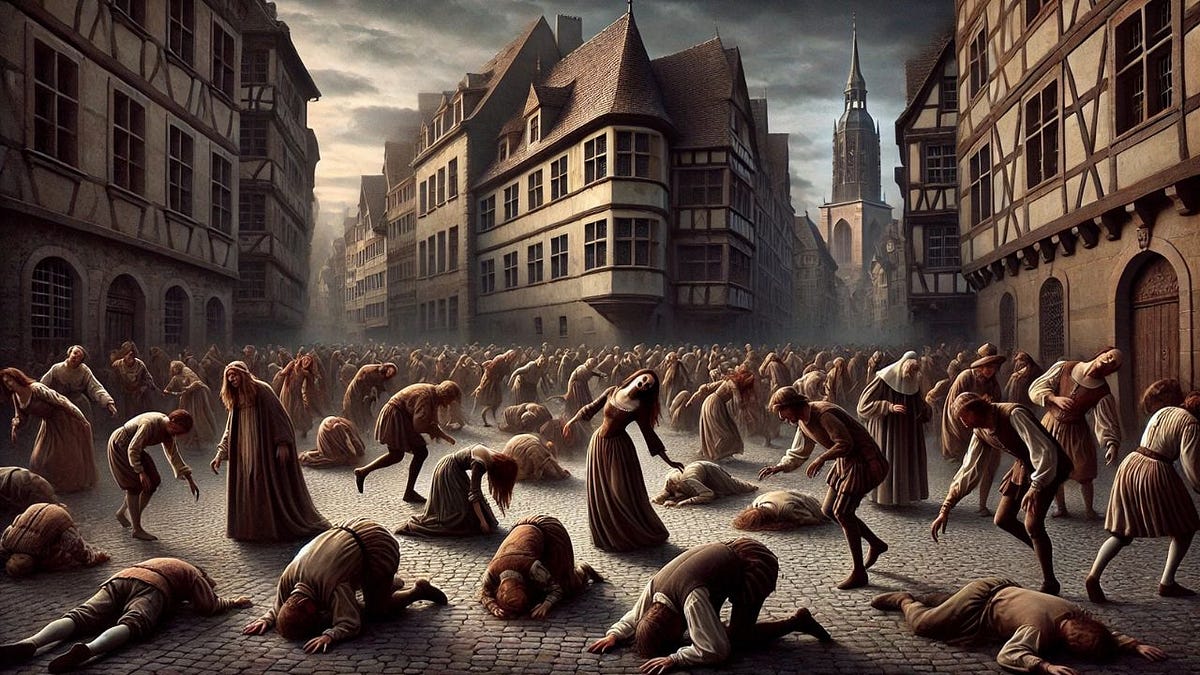Imagine this: Strasbourg, 1518. The summer heat is oppressive, the harvest is failing, and the people are stressed. Suddenly, a woman named Frau Troffea steps into the street and starts dancing. Not a graceful waltz or a celebratory jig — just wild, uncontrollable, keep-going-until-you-drop dancing. Within days, dozens join her. Then hundreds. For weeks, the city is consumed by a dancing frenzy that defies explanation. Welcome to the Dancing Plague of 1518, history’s most bizarre dance party.
The Beat Drops (and So Do the Dancers)
It all began in July when Frau Troffea, for reasons unknown, started dancing and couldn’t stop. She twirled and stomped for days, her feet bleeding, her body exhausted. Soon, others joined in — neighbors, strangers, even children. The city’s authorities, baffled but oddly pragmatic, decided the best solution was to lean into it. They hired musicians and cleared a public square, hoping the dancers would tire themselves out. Instead, the music fueled the frenzy.
By August, the streets were filled with hundreds of people dancing themselves to the brink of collapse. Some danced until they died of heart attacks, strokes, or sheer exhaustion. It was a spectacle of chaos, confusion, and, oddly, community.
The Humor in Hysteria
Let’s be real: this story sounds like the plot of a surreal indie film. A city gripped by a dancing epidemic? Authorities hiring a band to help? It’s equal parts hilarious and horrifying. But the humor lies in the absurdity of human responses to the inexplicable. When faced with a crisis, Strasbourg’s leaders essentially said, “Well, if you can’t beat ’em, hire a fiddler.”
Societal Layers in the Dance
The Dancing Plague wasn’t just a random act of mass hysteria — it was a symptom of deeper societal issues. Strasbourg in 1518 was a city on edge. Famine, disease, and economic hardship had left the population desperate and superstitious. Some historians believe the dancing was a form of collective stress relief, a physical manifestation of the people’s anxiety. Others think it was a religious phenomenon, sparked by fears of divine punishment.
Whatever the cause, the Dancing Plague reveals how humans cope with uncertainty. Sometimes, we pray. Sometimes, we protest. And sometimes, apparently, we dance until we drop.
Why This Matters While You’re Shuffling at a Wedding
The Dancing Plague may seem like a relic of a superstitious past, but it’s eerily relevant today. Think about the way we respond to modern crises — hoarding toilet paper, binge-watching TV, or joining viral dance challenges on TikTok. When the world feels out of control, we look for ways to regain it, even if those ways are… unconventional.
Plus, the story is a reminder that history isn’t always serious. Sometimes, it’s a chaotic, sweaty dance floor where logic takes a backseat to rhythm.
Final Bow
The Dancing Plague of 1518 may have been a tragedy for those who lived (and died) through it, but for us, it’s a fascinating glimpse into the human psyche. It’s a story of resilience, absurdity, and the lengths we’ll go to make sense of the senseless. And while we may never know exactly why Strasbourg danced itself into a frenzy, we can appreciate the lesson it teaches: when life gets weird, sometimes all you can do is dance.
P.S. Fun fact: Similar “dancing manias” occurred throughout medieval Europe. Apparently, the 1500s were just one big, awkward rave.
